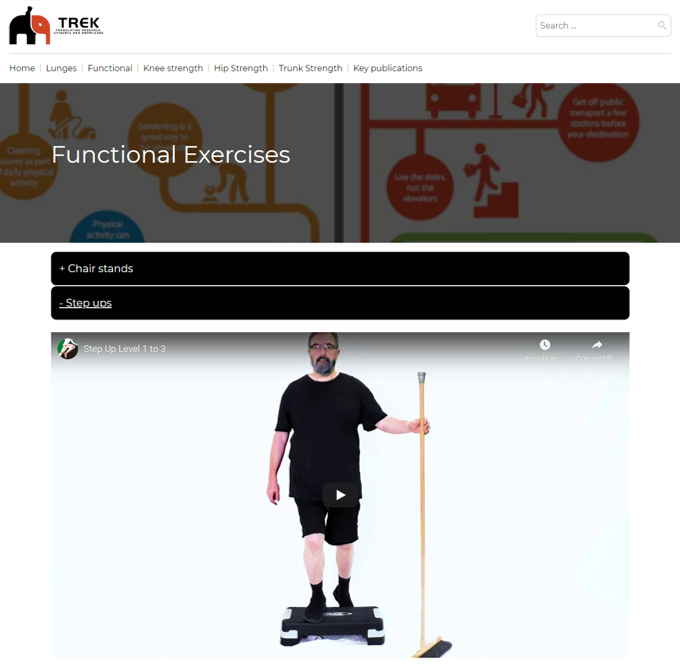Currently, there is no known way of ‘curing’ cartilage loss that occurs in knee osteoarthritis. But it doesn’t mean that there is nothing you can do!!
Treatment focuses on reducing symptoms and improving function of the joint. And the good news is that even those with more advanced stages of knee osteoarthritis can still make improvements to their pain and function!
As a general overview – treatment of knee osteoarthritis is demonstrated by the pyramid below
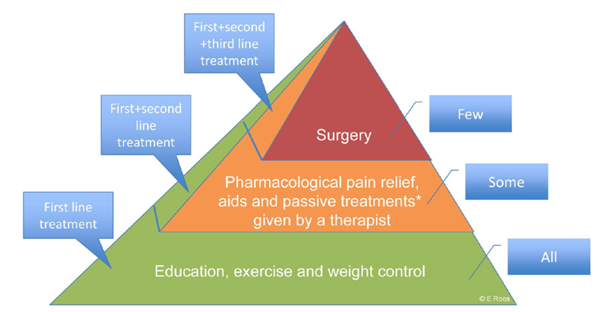
In Green – Education, exercise and weight loss (if necessary) should be offered to anyone with osteoarthritis right away to help them self-manage their symptoms.
In Orange– Pharmacological pain relief, aids and passive treatments given by a therapist are to be offered to those who have not improved with first line treatments. But note how education, exercise and weight loss are still really important at the same time!
In Red – Surgery (typically joint replacement) should only be offered when no other treatment has worked.
It is important to know that the above pyramid is not a one way street!
For example a patient who normally manages their symptoms with exercise and weight loss may, temporarily, have what is known as a ‘flare up’ of their symptoms. In these cases, the individual may choose to use medications or other modalities (e.g heat or ice) as demonstrated in the orange, second line treatment section of the pyramid to help reduce their symptoms temporarily. Once the flare up has passed, often individuals return to their previous management level.
Exercise is one of the best treatments for people who have trouble with their osteoarthritis and should be offered to anyone right away to help them self-manage their symptoms.
Exercise can reduce pain and, over time, improve function to make daily tasks easier. It’s also good for your body and mind and can lead to lots of positive things like a strong heart and good overall health.
It is often suggested that people with knee osteoarthritis become more physically active (do more of the things you enjoy, such as gardening, shopping, cooking), whilst also supplementing this with regular structured exercise (such as running, walking, strengthening training). Being more physically active by doing things that you enjoy in your free time will keep you happy and improve your overall health. Being active can also help distract from the pain and, if weight is a factor, help you burn off more calories.
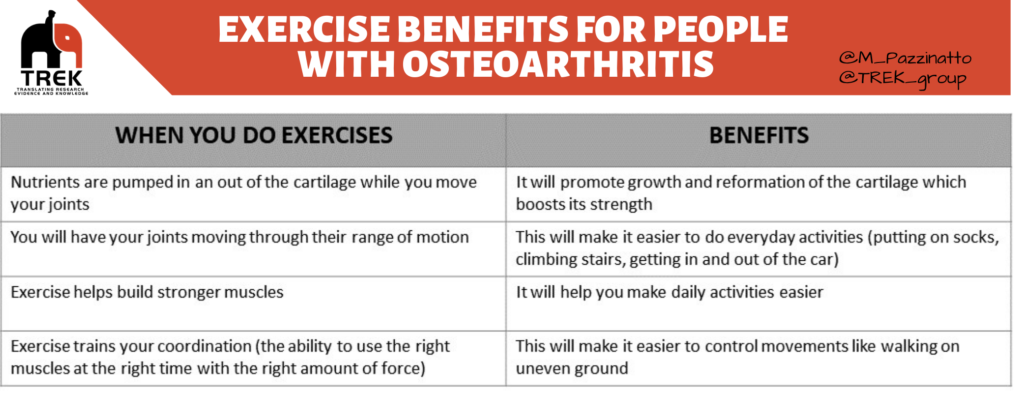
The benefits of exercise disappear when you stop exercising. To keep the effects of exercise, you have to keep exercising regularly. This is why it’s important to do exercises that you enjoy. This will help make exercise part of your daily routine. Examples of exercises that might work well are: walking, running, aquatic (water) exercises, dancing, cycling, and strength training.
Everyone, regardless of injury, illness or age should aim to be physically active for 30 minutes a day. These 30 minutes can be done in 10 minute bouts. At least twice a week, these bouts should be 20 minutes long and either maintain or increase in intensity. 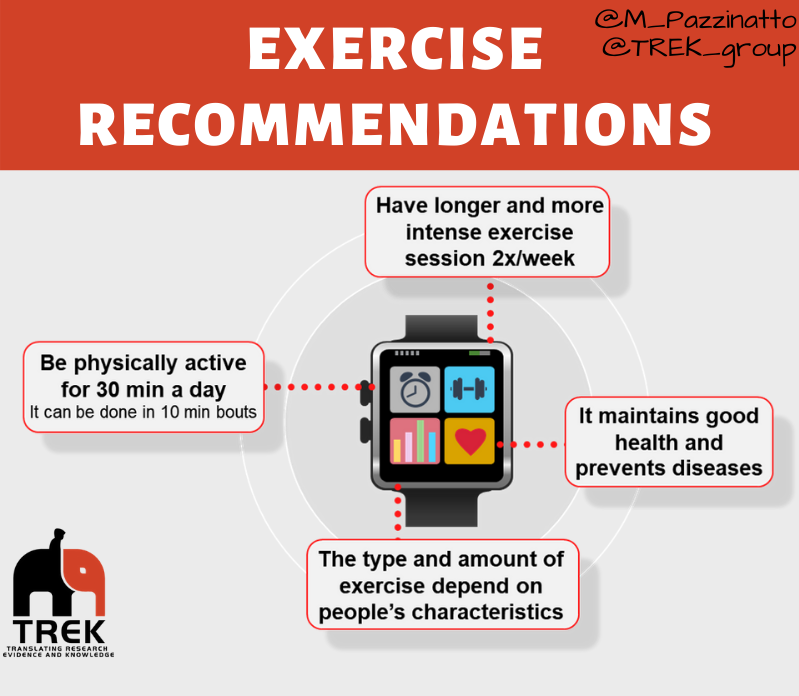
These activities should be slightly difficult and be done on top of your normal everyday activities. This is needed to maintain good health and prevent diseases (e.g. diabetes, certain types of cancer, high blood pressure among others).
These recommendations apply to people with osteoarthritis. The ideal type and amount of exercise depends on the person’s age, abilities, functional limitations, and health status. If you have not been physically active in the past, it may be a good idea to start slowly. See how you feel, and then gently increase the intensity.
If you have osteoarthritis and start exercising, you might start to feel pain. The pain may last a while, but it’s not dangerous to keep exercising. Everybody reacts to pain differently. Some people stop activities completely and rest as much as they can, this can lead to even more lost function. Some people ignore pain signals, which can lead to more injuries.
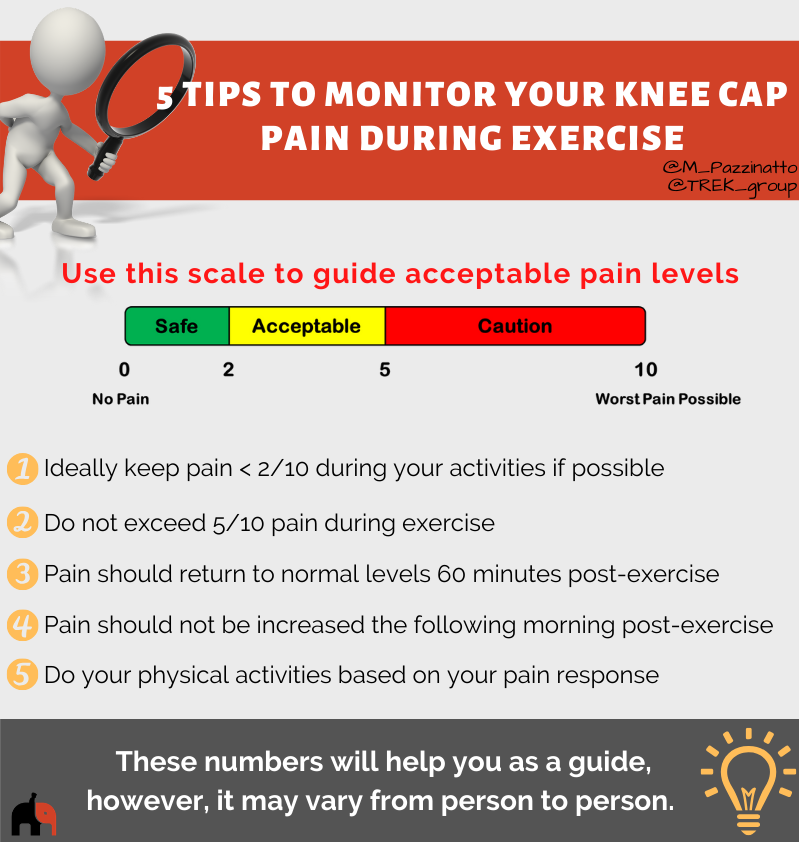
Pain is the main reason people with knee osteoarthritis seek treatment. It’s also the main reason people with knee osteoarthritis avoid exercise. If you’re in pain you want to avoid activity, but being less active can make your pain worse over time. Inactivity causes muscle weakness, the knee might feel less stable, you can gain weight, and your mood and sleep problems can get worse. All of these things can make you avoid activity even more. It’s a vicious cycle.
It’s normal to feel a bit of pain when exercising. You may have a bit of muscle soreness if you haven’t used these muscles regularly, or have some joint pain. The muscle soreness will decrease as you get used to exercising. The joint pain should not go over your acceptable limit of pain (see figure). The joint pain should lessen 24 hours after exercise to the same level as before exercise. These pain limits will be different for everyone and can change over time. Reduce the intensity of your exercise if joint pain goes over your acceptable limit or continues for over 24 hours.
It’s important to listen to your body and strike a balance when exercising. Focus on your exercise goals to distract yourself from the pain. Don’t forget to have fun!
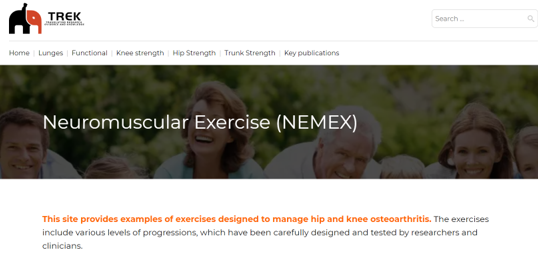 The Neuromuscular Exercise (NEMEX) website provides examples of exercises designed to manage hip and knee osteoarthritis. The exercises include various levels of progressions, which have been carefully designed and tested by researchers and clinicians.
The Neuromuscular Exercise (NEMEX) website provides examples of exercises designed to manage hip and knee osteoarthritis. The exercises include various levels of progressions, which have been carefully designed and tested by researchers and clinicians.
The exercise videos provided have been based on the NEMEX program to help promote independence. It is recommended you seek appropriate guidance from a physiotherapist or other suitably qualified health professional to ensure you perform exercises of appropriate level for you, and with good quality. Such supervision and guidance will optimise the chance of exercise helping to improve you management of hip and knee pain.
Key facts about NEMEX for hip and knee osteoarthritis
- Feasible in patients with severe hip and knee joint replacement surgery
- Forms part of successful implementation program for people with hip and knee osteoarthritis – GLA:D™ – program developed by Ewa Roos and Soren Skou
- Improves pain, function and quality of life
- Associated with reduction in use of analgesia and sick days from work
- Program developers include Eva Ageberg, Anne Link and Ewa Roos
See more details in: https://nemex.trekeducation.org/

